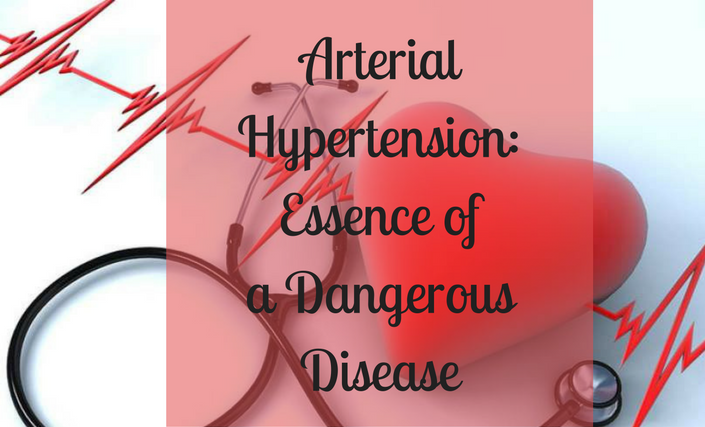What is Arterial Hypertension?
Arterial hypertension is a disorder manifested by increased blood pressure. There are two types of blood pressure: systolic and diastolic. With a cardiac contraction (systole), the blood penetrates the blood vessels and put maximum pressure on their walls. Then, when the heart (diastole) relaxes, the pressure in the arteries decreases to a certain limit.
The maximum pressure in the vessels supposes systolic pressure, the minimum arterial pressure – diastolic. The measurement result is usually expressed by a fraction, in the denominator of which the systolic index, in the denominator – diastolic pressure indicator. Arterial pressure in healthy people is subject to significant physiological fluctuations. The lowest blood pressure is determined in the morning, on an empty stomach, at rest, i.e. in those conditions in which the standard metabolism is determined, so this pressure is called the basal metabolic rate. A short-term increase in blood pressure can be observed in case of:
A short-term increase in blood pressure can be observed in case of:
- great physical loading, especially in untrained individuals;
- psychic excitement;
- alcohol consumption;
- strong tea, coffee drinking;
- excessive smoking;
- severe pain attacks.
Currently, the experts of the World Health Organization and the International Society for the Study of Hypertension are considered to be the optimal pressure below 120 and 80 mm Hg. The upper limit of the norm is 139/89 mm Hg.
Increase in blood pressure (systolic, diastolic or both) is called arterial hypertension (hypertension, hypertensive disease). The lower limit of the norm is the pressure of 100/60 mm Hg. The decrease in systolic pressure below 100 mm Hg. and diastolic below 60 mm Hg. is called hypotension.
According to Canadian Neighbor Pharmacy, it is allocated two types of arterial hypertension:
- essential, or primary arterial hypertension symptomatic;
- secondary arterial hypertension, which appears as a symptom of kidney disease, endocrine diseases.
Risk factors for primary arterial hypertension:
- heredity (cases in the family of arterial hypertension, cardiovascular diseases);
- diabetes;
- excessive salt consumption;
- smoking;
- alcohol consumption;
- low physical activity;
- obesity;
- emotional stress;
- occupational hazards.
Symptoms of Hypertension
There are the following symptoms characteristic for arterial hypertension:
- headache;
- dizziness;
- blurring of vision, reduction in vision;
- buzzing in ears;
- mood imbalance, irritability;
- rarely cardiac pain;
- palpitation.
Diagnosis of Arterial Hypertension
To diagnose arterial hypertension, you have to undergo the following tests and examinations:
- general analysis of blood and urine;
- blood chemistry;
- daily monitoring of blood pressure;
- electrocardiography;
- echocardiography;
- fundospcopy;
- kidney ultrasound.
There is a common misconception that patients with hypertension feel when they have high blood pressure. Both patients and doctors have such a misconception. A person can feel good, and therefore will be surprised if the doctor tells him that blood pressure is increased and this is a sign of the disease onset. Unfortunately, many do not know that the pressure is increased. Without measuring the pressure, it cannot be said that it is normal on the grounds that nothing hurts.
Treatment of Arterial Hypertension
With a minimum increase in blood pressure (below 160/100) and in the absence of additional risk factors for health, it is sufficient to eliminate excess body weight at first, restrict intake of table salt and alcohol, stop smoking and increase motor activity. It is very important to create a calm psychological climate at home and at work, to be optimistic and benevolent. These measures are also advisable with a greater increase in pressure and a high risk of cardiovascular complications, but in these cases, you can not do without taking medication. The most effective groups of drugs used to treat hypertension:
- ACE inhibitors (Lisinopril, Enalapril, Perindopril).
- Sartan (Losartan, Valsartan).
- β-adrenoblockers (Bisoprolol, Metaprolol, Carvedilol).
- Diuretics (Hypothiazide, Indapamide, Verospiron, generic Lasix or Furosemide).
- Antagonists of calcium (Amlodipine, Nifedipine, Verapamil).
What is Generic Lasix?
Generic Lasix name is Furosemide. This diuretic is applied in cases of arterial hypertension to decrease blood content in the organism. There are cases when Furosemide is applied in the following list of disorders:
- Chronic heart failure;
- Chronic renal failure;
- Nephrotic syndrome;
- Acute renal failure, with burns and pregnancy;
- Diseases of the liver.
This medication has almost immediate effect. If you feel a demand in Lasix application, grapple with its instruction for use here. You will get to know all the details about generic Lasix as one of the most effective diuretics.
Tags: arterial hypertension, Lasix
